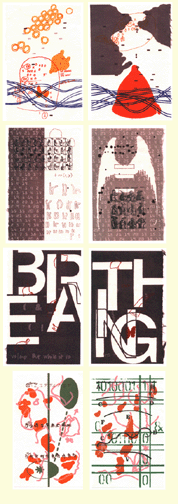
Where the Visual Meets the Verbal
Robert Miltner
continued . . .
![]()
Third Person, Plural

Through the collaboration of two working artists, the contribution of each party creates a kind of third person which takes on parts of the identities of the two individuals, similar to what poet Robert Bly calls, under different circumstances, a "third body" which comes "out of the invisible world and walks with them . . . when two people are close" (62), as "Their breaths together feed someone whom we do not know. . . . They obey a third body that they share in common" ("A Third Body" 61). This physical bringing together of collaborators further creates an intellectual connection, what Gerard-Georges Lemaire, referring to the "cut-up" collaborations between William Burroughs and Brion Gysin, calls the "third mind," that is, something which goes beyond mere literary collaboration, creating rather "the complete fusion in a praxis of two subjectivities, two subjectivities that metamorphose into a third; it is from this collusion that a new author emerges, an absent third person, invisible and beyond grasp, decoding the silence" (18). It is the third body, with its third mind, which creates an analogous third image where the verbal meets the visual.
There are, according to poet Charles Simic, three kinds of images. Of the first two, which function independently, there are those images, Simic notes, which "are those seen with eyes open in the manner of realists" both in literature and art, while the second are those "images we see with eyes closed" and are of the kind known to "Romantic poets, surrealists, expressionists, and everyday dreamers" (60). The third kind of images are those Simic finds being used in Joseph Cornell's boxes; these images, Simic observes, take both from the dream and from the real, co-existing without synthesis. Instead,
[t]hey tempt the viewer in two opposite directions. One is to look and admire the elegance and other visual properties of the composition, and the other is to make up stories about what one sees. In Cornell's art, the eye and the tongue are at cross purposes. Neither one by itself is sufficient. It's the mingling of the two that makes up the third image. (60)
The third kind of image, then, rather than operating as synthesis or collaboration between the verbal and visual, between poet and artist, operates instead as a continuous dialogue between the poet and the artist; the eye and ear, operating at what Simic calls "cross purposes," are positioned as debaters in an ongoing, divergent discussion. While this adds the essential tension to poetry, the opposition necessary for progress, as Blake suggested, the dialogue requires the two parties, poet and painter, ear and eye, to generate a common vocabulary. Describing his writing poems and prose in response to the boxes of Joseph Cornell, Simic states that ". . . for a long time I wanted to approximate his method, to make poems from found bits of language" (Preface xii). By learning to use Cornell's method, Simic is able to expand his own vocabulary, or rather the way in which he selects words and images for his working vocabulary, comparable to the one from which Cornell "selects" the found object he includes in his boxes; in his poems, Simic, then, drawing from the methodology of one visual artist, is able to expand his poetic vocabulary through a collage of found objects, both words and images, by "reassembling fragments of preexisting images in such a way as to form a new image" (18).
For the poet, words are both a way of seeing and of speaking. For the visual artist, the medium and the images constitute a form of expression. Ekphrasis, wherein poets and artists collaborate, is a symbiotic process of action and reaction in which each artist acts as the other's ideal audience, and which therefore produces a cooperative artistic product. More than that, collaboration between artists produces valuable personal and professional friendships, so that beyond art imitating life, it actually integrates art into the lives of the artists and writers as well. Collaboration is more than merely responding to art, it is equally an engaging in dialogue between the visual and the verbal artist, initiating an open-ended conversation which transgresses the borders between mediums and builds bridges which both connect artistic communities and create friendships.
— Robert Miltner
|
Copyright © Enculturation 2001 |